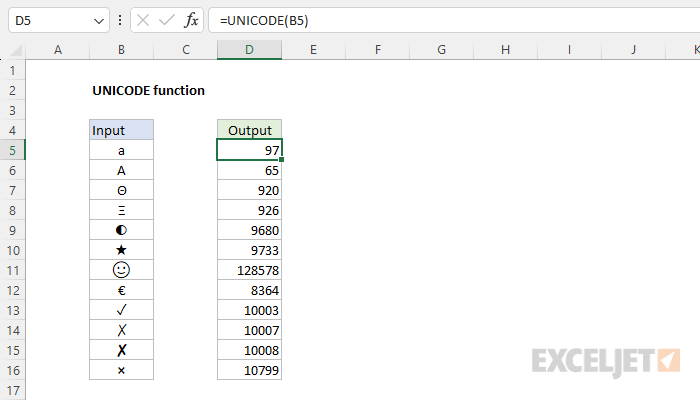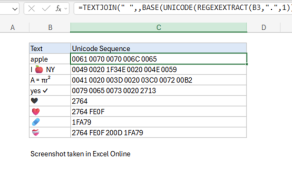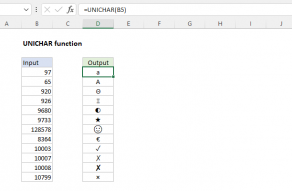Purpose
Return value
Syntax
=UNICODE(text)- text - Unicode character to convert to number.
Using the UNICODE function
The Excel UNICODE function returns a number (code point) corresponding to a Unicode character given as text. The result is a number in decimal notation. For example, the Euro symbol (€) is code point 8364 in decimal notation, so UNICODE returns 8364:
=UNICODE("€") // returns 8364
To get the hexadecimal value, which is usually how unicode code points are expressed, you can use the DEC2HEX function like this:
=DEC2HEX(UNICODE("€")) // returns 20ACIf text is more than one character, UNICODE returns the number of the first character:
=UNICODE("a") // returns 97
=UNICODE("apple") // returns 97
Note: the UNICHAR function performs the opposite conversion, returning the Unicode character at a given code point.
Unicode numbers
Unicode assigns each character a unique numeric value and name. This numeric value is referred to as a "code point". Code points are typically represented by the "U+" notation followed by hexadecimal numbers. For example, the code point for the capital letter A is U+0041, and the code point for the "😊" emoji is U+1F60A. It is important to understand that the UNICODE function does not return Unicode code points in hexadecimal number format, but rather in decimal number format.
Examples
In decimal representation, the code point for "A" is 65, and the code point for the "😊" emoji is 128522, therefore:
=UNICODE("A") // returns 65
=UNICODE("😊") // returns 128522
In Excel, you can use the DEC2HEX function to translate numbers from hexadecimal to decimal if needed.
=DEC2HEX(UNICODE("😊")) // returns 1F60AHere are some more useful Unicode symbols in Excel, along with the decimal number code point:

Note: As of this writing in October 2025, emojis in Excel Online (i.e. the web app) appear in color, but emojis in the desktop version of Excel appear in black and white only. See Emoji Wizard for a comprehensive list of emoji and their corresponding unicode sequences.
About Unicode
Excel supports Unicode characters, which are characters that can represent most of the world's writing systems. Unicode is a computing standard that assigns a unique number (code point) to each character, regardless of the font, platform, or program. Because Unicode is a superset of other character sets, it is very large. The first 128 code points in Unicode align exactly with the ASCII characters. In total, Unicode contains over 140,000 characters spanning more than 160 modern and historic scripts, plus thousands of symbols and emoji.
Unicode can be implemented in different encodings, most commonly UTF-8 and UTF-16. It is estimated that over 90% of websites on the internet use UTF-8.
UNICODE versus UNICHAR
The UNICODE function translates a Unicode character into a code in decimal number format. To perform the opposite conversion, see the UNICHAR function, which translates a given code in decimal number format into a Unicode character.
=UNICHAR(HEX2DEC("1F60A")) // returns "😊"











